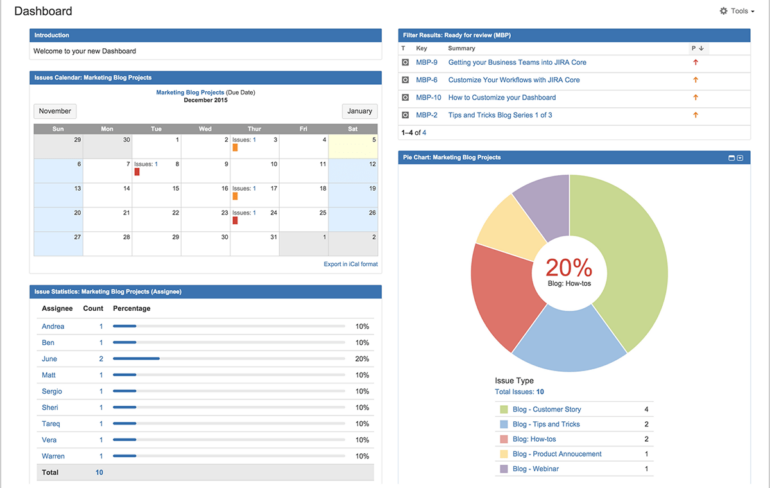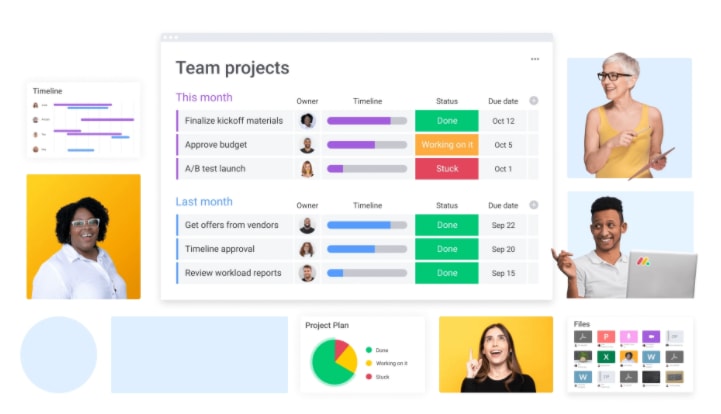DevOps developers must stay on the same page to ensure they meet deadlines, minimize errors, and nothing slips through the cracks. The collaboration tools in this guide can help developers achieve those goals. To help you choose the right one for your software development team, we will review the following collaboration software solutions in terms of their features, pros, cons, and pricing:
- Jira: ideal for Agile software development teams needing collaboration features.
- Bitbucket: best for individual developers or teams looking to collaborate on code, streamline development, track changes, and more.
- Microsoft Teams: an excellent pick for those seeking a popular developer tool that focuses solely on collaboration.
- Monday.com: a great choice for DevOps developers seeking a customizable tool for collaboration and managing projects.
Jump to:
Jira

Jira is project management software from Atlassian made with Agile development teams in mind. It has some collaboration features out of the box to help DevOps developers stay in sync, and it also integrates with tons of popular third-party tools to get that desired functionality.
Features of Jira
Jira helps DevOps developers manage projects and collaborate through the following features:
- Kanban and Scrum boards.
- Issue and bug tracking.
- Shareable roadmaps.
- Integrations with third-party collaboration tools.
- Customizable templates.
- Multiple views.
- Advanced reporting.
- Open DevOps.
Developers can use Jira’s Kanban and Scrum boards to visualize workflows, stay efficient, and view their software development team’s progress in real-time. The collaboration tool’s issue and bug-tracking features allow developers to spot, track, and fix bugs with ease.
Jira has shareable roadmaps (basic and advanced) to keep everyone on the same page, including stakeholders. And, to get added collaboration, you can integrate Jira with Slack, Zoom, and other popular third-party apps.
Other Jira features developers may love include customizable templates for DevOps, Kanban, Scrum, tracking, etc., multiple views, and robust reporting (velocity charts, sprint reports, release burndowns). Lastly, Jira has Open DevOps, a feature that lets developers enjoy all their top tools in one place to reduce cycle time and accelerate deployments.
Pros of Jira
Jira has many pros that make it such a popular collaboration and project management tool, including:
- Multiple project templates.
- Works for teams of all sizes.
- Open DevOps.
- Bug tracking.
Jira’s templates let developers get started with minimal setup. The collaboration software can be used for teams, both big and small, with the ability to scale from one to 20,000 users.
Open DevOps gives developers extended functionality in one place to boost productivity, and having built-in bug tracking is another plus.
Cons of Jira
Jira’s cons are:
- Challenging interface.
- Cost with advanced features.
- Migration troubles.
Not everyone will love Jira’s interface. It can be especially challenging for non-technical users to adapt to. As you try to unlock more advanced features, Jira can become pricy. And, should you decide to migrate to other project management software, you could find that task daunting, as Jira does anything but make it easy.
Pricing of Jira
Jira’s pricing plans are as follows:
- Free: For 10 users.
- Standard: $7.75 per user, per month.
- Premium: $15.25 per user, per month.
- Enterprise: Custom pricing.
Unlimited project boards, timeline, backlog, reporting, and insights come with the Free plan.
Standard gives you data residency, audit logs, user roles, permissions, and support during business hours. Premium unlocks advanced roadmaps, unlimited storage, and guaranteed uptime. And Enterprise offers unlimited sites and around-the-clock support.
Read our review of Jira for more about its features and benefits.
Bitbucket

Like Jira, Bitbucket is a collaboration tool for DevOps developers from Atlassian. Beyond collaboration, Bitbucket comes complete with features for continuous integration and delivery, code review, and more.
Features of Bitbucket
Bitbucket offers many attractive features for developers, including:
- Jira integration.
- Code reviews.
- Pipelines.
- Integrations with popular programmer tools.
Bitbucket’s seamless Jira integration allows developers to collaborate when using the software. Beyond that, Bitbucket has comprehensive code review to help you spot and fix bugs prior to deployment.
The Pipelines feature offers integrated CI/CD capabilities for automating code from test production and eliminates the need for server and configuration management, repository synchronization, etc. And while Jira integration may take the spotlight, Bitbucket also integrates with popular developer tools like GitHub, CircleCI, Jenkins, etc.
Pros of Bitbucket
Bitbucket’s pros include:
- Easy to use.
- Team collaboration.
- Integration with Jira and other popular tools.
- Two-factor authentication.
Bitbucket may be full of features, but it is also user-friendly and not as complex as one would think. Developers have multiple ways to collaborate via commenting, code review, Jira integration, etc., and the fact that Bitbucket integrates with other widely-used developer tools is another plus. Security is another strong point, as the software has two-factor authentication, IP allowlisting, and more.
Cons of Bitbucket
Bitbucket cons include:
- High price for small teams.
- Outdated interface.
- Sluggish performance.
Small development teams may find Bitbucket out of their budget range. Its interface could use a modern facelift to match some competitors. And when dealing with large repositories or complex operations, some users have found Bitbucket to be slow to respond.
Pricing of Bitbucket
Bitbucket pricing is divided into cloud (handled by Atlassian) and Data Center (managed by you) options. Cloud pricing is as follows:
- Free: Limited features.
- Standard: $3 per user, per month for a minimum of five users.
- Premium: $6 per user, per month for a minimum of five users.
The Free plan offers 50 monthly build minutes, 1GB of storage, 10 deployment environments, Jira integration, unlimited private repositories, CI/CD, and more for up to five users. Standard offers 2,500 monthly build minutes, 5GB of storage, and 50 deployment environments. Premium ups the build minutes to 3,500 per month and offers 10GB of storage.
Data Center pricing is as follows. There is a 30-day free trial available:
- $2,300 for 25 users.
- $4,200 for 50 users.
- $7,600 for 100 users.
Data Center plans come with priority support, Atlassian disaster recovery, high availability, and more.
Rad our review of Bitbucket for more about its features and benefits.
Microsoft Teams

While some of the other developer tools in this list represent all-in-one project management solutions, Microsoft Teams tends to focus solely on collaboration.
Features of Microsoft Teams
Microsoft Teams has plenty of collaborative features to help DevOps developers share ideas, fix issues, and stay in touch. Some of its highlights are:
- Online meetings.
- Feature-rich video conferencing.
- Chat.
- File sharing.
- Content editing.
- Integrations.
Many developers work remotely, with some having offices on the other side of the globe. That distance is no longer an obstacle with collaboration software like Microsoft Teams, as it can host online meetings for up to 1,000 users. Hold a video conference with Microsoft Teams, and you can enjoy bells and whistles like custom backgrounds, live captions in multiple languages, screen sharing, recordings, muted background noise, a whiteboard, and more.
Microsoft Teams also has a chat feature with message translation, @mentions, rich text editing, team channels, video replies, etc. Online video meetings and chat are not the only ways to collaborate, though, as Teams also has file sharing, real-time content editing, version history tracking, and integrations with Slack, Trello, and other collaborative programmer tools.
Pros of Microsoft Teams
There are many reasons to choose Microsoft Teams for your software development team’s collaborative needs, such as:
- Tons of collaboration features.
- User-friendly.
- Third-party integrations.
- Solid audio and video quality.
As collaboration software, Microsoft Teams is tough to top since it offers so many ways to communicate (video, chat, file sharing, etc.) The developer tool is easy to use, integrates with popular third-party tools for even more functionality, and, most importantly, offers excellent audio and video quality for its meetings.
Cons of Microsoft Teams
Microsoft Teams does have some disadvantages, such as:
- Screen sharing issues.
- Familiarity of other collaboration apps.
- Lack of features outside of collaboration.
Some users have reported glitches when trying to share screens in Microsoft Teams. You may prefer chatting over more familiar apps like Slack instead of making the switch to Teams, and it may not fit the bill for developers seeking all-in-one solutions that offer collaboration plus project management capabilities.
Pricing of Microsoft Teams
Microsoft Teams’ pricing plans are as follows:
- Free: Simple collaboration features.
- Essentials: $4 per user, per month.
- Microsoft 365 Business Basic: $6 per user, per month.
- Microsoft 365 Business Standard: $12.50 per user, per month.
- Microsoft 365 Business Premium: $22 per user, per month.
The Microsoft Teams Free plan offers online meetings for up to 100 users with a 60-minute meeting duration. Teams Essentials increases users by up to 300 participants per meeting and adds file sharing, chat, and live captions. The Microsoft 365 plans unlock other apps like OneDrive, Word, Excel, PowerPoint, etc., and add perks like recordings, webinars, reporting tools, and advanced security.
SEE: Microsoft Teams version 2 is Windows only for now
Monday.com

Monday.com is another popular project management tool for DevOps developers that offers collaboration features, along with customization options and a user-friendly interface.
Features of Monday.com
Some of Monday.com’s top collaborative and project management features include:
- Workdocs.
- File sharing.
- Third-party integrations with collaboration apps.
- Customizable dashboards and projects.
- Views for Gantt, Kanban, etc.
- Integrated time tracking.
Monday.com offers multiple ways for DevOps developers to collaborate. The workdocs feature allows for co-editing in real-time, plus there is file sharing. Monday.com also integrates with some of the most popular collaboration tools, including Microsoft Teams, Dropbox, and Slack.
Other features that make Monday.com a handy programmer tool include dashboards that can be customized. You can also customize projects through 30 different column types. There are various views to see your data and progress (Kanban, Gantt, timeline, form, calendar, map), and time tracking comes included.
Pros of Monday.com
The following pros are some reasons why Monday.com is such a popular developer tool:
- Plenty of views.
- Numerous integrations.
- Customization.
- Solid support.
There is no shortage of views in Monday.com, which gives developers plenty of options for visualizing progress. The collaboration software has numerous integrations with the top apps and programmer tools for added functionality, and it is also highly customizable. Monday.com also offers tons of tutorials and superb support should your software development team need it.
Cons of Monday.com
The main cons of Monday.com include:
- Slow performance.
- High cost for advanced features.
- Limited task dependencies.
Some say that Monday.com suffers from occasional sluggish performance. If you want more advanced features, you will pay a premium that may exceed your development team’s budget. Task dependencies are another area of improvement.
Pricing of Monday.com
Monday.com has several pricing tiers for DevOps developers to choose from:
- Free: For two seats.
- Basic: $8 per seat, per month.
- Standard: The most popular option at $10 per seat, per month.
- Pro: $16 per seat, per month.
- Enterprise: Custom pricing.
The Free plan comes with over 200 templates, unlimited docs, and up to three boards. Basic serves unlimited free viewers, unlimited items, 5GB of file storage, and priority support. Standard includes Gantt, calendar, and timeline views, 250 integrations and automations per month, and guest access. Pro offers a chart view, time tracking, 25,000 monthly automations/integrations, and formula and dependency columns. And Enterprise offers advanced reporting and analytics, premium support, tailored onboarding, multi-level permissions, and top-notch security and governance.
Read our review of Monday.com for more about its features and benefits.
What to look for in collaboration tools
Beyond making sure the price fits their budget, DevOps developers should ensure collaboration tools have all the features they need to succeed. Some of the more popular features to look for include video conferencing, chat, @mentions, notifications, file sharing, document editing, screen sharing, and integrations with popular third-party collaboration apps like Slack. You may also want to find collaboration software with project management features like multiple views, task management, reporting, resource management, time tracking, etc., to keep everything in one place.
Final thoughts on collaboration tools for DevOps developers
Although there are many collaboration tools on the market, the ones listed above are among the best for DevOps developers. Look at the collaborative features for each to make sure they provide everything your software development team needs to share ideas and communicate. Before making that final decision, ensure there is enough room in your budget to pay for the pricing plan that offers those specific features, as some only unlock advanced capabilities for a premium.






